Glossary of wildlife words
Below is a list of wildlife words you might not have heard of, with explanations of what the words mean.
If you think there should be a word that isn't here, get in touch.
A
Abundance - The total number of individuals of a species present in an area.
Ancient tree - A tree that is remarkably old for its species, surpassing the normal life expectancy.
Ancient woodland - A woodland that has existed continuously since 1600 or before in England, Wales and Northern Ireland.
AONB - Area of Outstanding Natural Beauty, land protected by the Countryside and Rights of Way Act 2000.
Attenuation - To become weaker or thinner, or taper gradually.
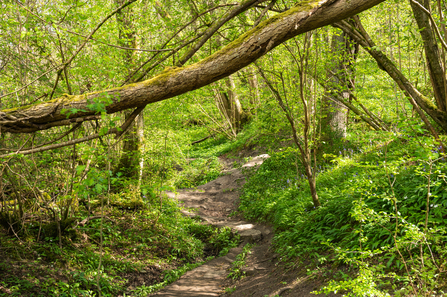
Lower Woods (c) Nathan Millar
B
Biodiversity - The variety of living things in a particular area or in the world.
C
Catchment - The area of land where rainwater runs off into a river, lake, or other body of water.
Citizen science - When members of the public take part in and contribute towards scientific research. Get involved here.
Climate emergency - A situation in which urgent action is required to reduce or halt climate change and avoid potentially irreversible environmental damage resulting from it.
Conservation grazing - When cattle, sheep or ponies have been introduced to help create and maintain open spaces, especially heathland. Thousands of years ago, a variety of animals including European bison would have naturally taken on this role. Find out more about conservation grazing in the Forest of Dean.
Connectivity - The degree to which wildlife can freely move from place to place across a landscape.
Coppiced or coppicing - To cut back a tree or shrub to ground level in order to stimulate growth.
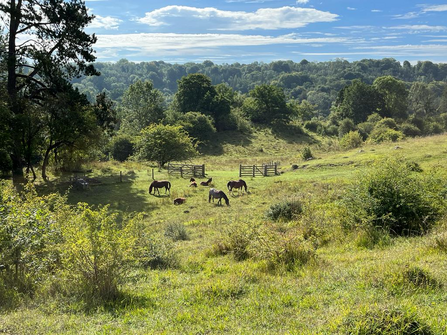
Daneway Banks (c) Elizabeth Pilkington
D
Deciduous - A tree or shrub which sheds its leaves annually.
Decompose - To decay, separate and change into simpler parts.
E
Echolocation - When animals find their way and locate objects by emitting sound waves which bounce back to the animal.
Ecological survey - A survey which identifies the habitats and species within an area.
Ecosystem - A complex of living organisms and their interactions with each other as well as the physical environment around them.
Ecosystem engineer - Species that make changes to their habitats in a positive way, and create new habitats within the ecosystem they live in.
Ecosystem services - Direct and indirect ways in which wildlife and nature benefits humans.
Encroaching - To move into or onto an area in a gradual way, taking over space that belongs to another.
Eutrophiciation - The addition of nutrients to water in lakes and rivers.
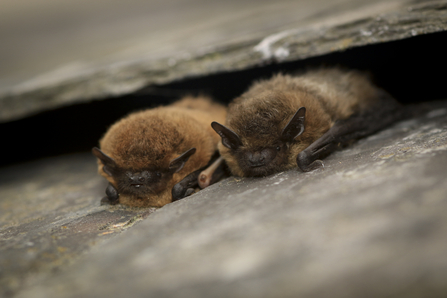
Common pipistrelle (c) Tom Marshall
F
Fauna - Animal life present in a region or time.
Feasibility study - A study that assesses the viability of a project, carried out by conducting biological, ecological, social and legal studies.
Floodplain - A flat area next to a river or stream that gets covered in water when the river floods.
Flora - Plant life present in a region or time.
Forage - When animals search for food.
G
Ground truthing - When a location shown on a map or satellite image is checked on the ground to validate facts. HabiMap is ground truthing and renewing data behind maps as evidence to support nature's recovery.
H
Habitat - The natural environment in which an animal or plant usually lives.
Habitat mapping - Researching and monitoring what grows where, to create maps that can be used to help communities, landowners, and farmers to make decisions. Also see HabiMap.
Home range - An area over which an animal or group of animals regularly travels in search of food or mates, and which may overlap with those of neighbouring animals or groups of the same species.
Homogenous - Composed of species or parts having qualities that are the same type.
Host plant - A plant which organisms like insects live on and live off of.
Hydrology - The study of the distribution and movement of water both on and below the Earth's surface.
HabiMapping (c) Nick Turner
I
Invasive species - A species that has moved to a place where it is not naturally found, and causes harm.
Interspecies competition - When individuals of different species compete for food or resources.
Intraspecies competition - When individuals of the same species compete for food or resources.
K
Keystone species - Species that drastically impact and define ecosystems in a positive way. Without them, the ecosystem they live within would be very different.
L
Larder - A place where animals keep their food.
Larva - A young insect that has hatched but not yet developed into a pupa or adult. Also used to describe the young of some animals such as frogs.
Local extinction - The disappearance of all individuals of a species in a certain area.
LNR - Local nature reserve, a statutory designation made under Section 21 of the National Parks and Access to the Countryside Act 1949 by principal local authorities. LNRs are for people and wildlife. They are places with wildlife or geological features that are of special interest locally.
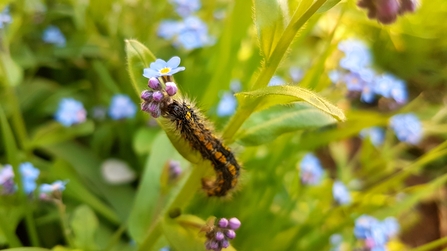
Scarlet tiger caterpillar forget-me-not (c) Ellen Winter
M
Migration - The movement of an animal or animals from one place to another.
Monoculture - Cultivation or growth of only one plant, crop or species in an area.
Mosaic of habitats - An area with multiple habitats found close together in an ecosystem.
Murmuration - Large groups of birds, usually starlings, that all fly together and change direction together.
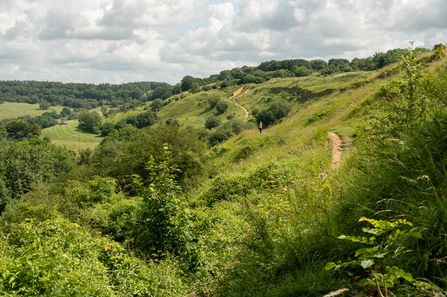
Crickley Hill (c) Nathan Millar
N
NNR - National Nature Reserve, an area designated by Natural England, the designation is to protect important habitats, species and geology, and to provide 'outdoor laboratories' for research.
Native - A species that is present naturally in an area or habitat, in its known natural range.
Natural flood management - When nature and natural processes are used to reduce the risk of flooding. Find out more.
Nature recovery zone - Working closely with our neighbouring landowners and farmers beyond the boundaries of nature reserves to create much larger wildlife-friendly areas that importantly connect with each other, effectively creating ‘super reserves’. Find out more.
Nature-based solution - actions that protect, manage and restore natural ecosystems in order to address societal challenges. Find out more.
Nocturnal - Being active during the night, rather than the day.
Non-native - A species that is present in an area or habitat that is outside of it's known natural range.
O
Organic - Produced without the use of chemicals.
Overwinter - To live through the winter.
P
Parasite - Something that lives in or on another species -its host- and takes benefits at the others expense.
Parasitism - The relationship between a parasite and their host.
Peat - A substance like soil that was formed by partially decayed plants, usually found in wet regions. Peatlands are crucial carbon stores, locking away over three billion tonnes of carbon in the UK alone. Also see how to go peat free at home.
Pesticide - A substance used to kill and repel animal and plant life that are considered harmful to cultivated plants and animals.
Pheromones - A chemical released by an individual that triggers a social response in members of the same species.
Pollard - To cut off the top and branches of a tree to encourage new growth at the top.
Population density - A measurement of the concentration of individuals within a species in an area.
Pupa - The life stage of some insects after the larva stage, usually enclosed in a cocoon or case, just before adulthood. Butterfly and moth pupa are sometimes called a chrysalis.
Marsh fritillary pupa © Vaughn Matthews
R
Regenerative Farming - The use of practices that increase soil health to the best extent for that system and its location and at the same time manging the farm to mitigate the negative effects of human and livestock disruption. Regenerative farming follows the following principles:
- Reduce or eliminate tillage/soil disturbance
- Never leave bare soil
- Maximise plane diversity
- Integrate livestock and cropping systems
- Reduce or eliminate synthetic agrochemicals
Read this blog about regenerative farming to find out more.
Riparian - The area adjacent to rivers, streams, lakes and seas.
Roost - A place where birds or bats rest or sleep.
S
Sapling - A young tree, one that is small due to its age, rather than external factors.
Scrape - Shallow temporary ponds that hold water that has come from rain or flooding.
Sediment - The soil and nutrients that have fallen to the bottom of a river, lake, or other body of water.
Seedling - A very young plant or tree, trees that are smaller and younger than saplings.
Species-rich - An area or community with a high number of species present.
SSSI - Special Site of Scientific Interest, a conservation designation given to areas with a particular geological or ecological interest.
Stepping stones - Unconnected areas or patches of habitat that allow wildlife to move across landscapes, similar to wildlife corridors.
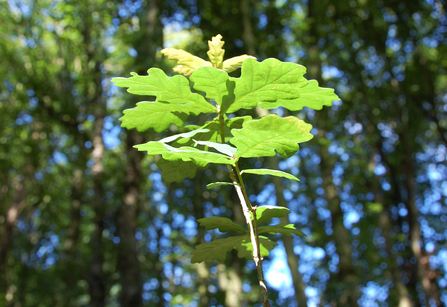
Oak sapling (c) Scott Petrek
T
Territory - An area within the home range that is actively protected, both in interspecies and intraspecies competition for the area or resources within.
Translocation - The movement of something - for example an animal - from one place to another.
V
Veteran tree - A tree that shows ancient characteristics due to its size, age, condition, history, or position, sometimes has a cultural or historical interest.
W
Wader - A type of bird that walks in water to find food - eg herons, bitterns, storks. Find out more about wading birds here.
Water table - The level below the surface of the ground at which you start to find water.
Wildlife corridor - A pathway for wildlife that connects nature reserves and green spaces together across the landscape. Similar to stepping stones.
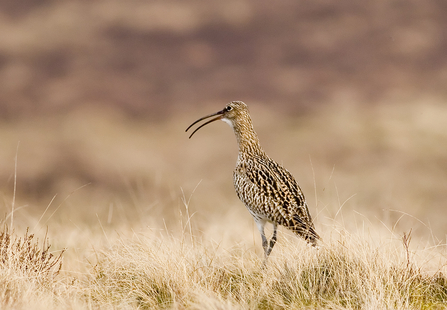
Curlew (c) Damian Waters
